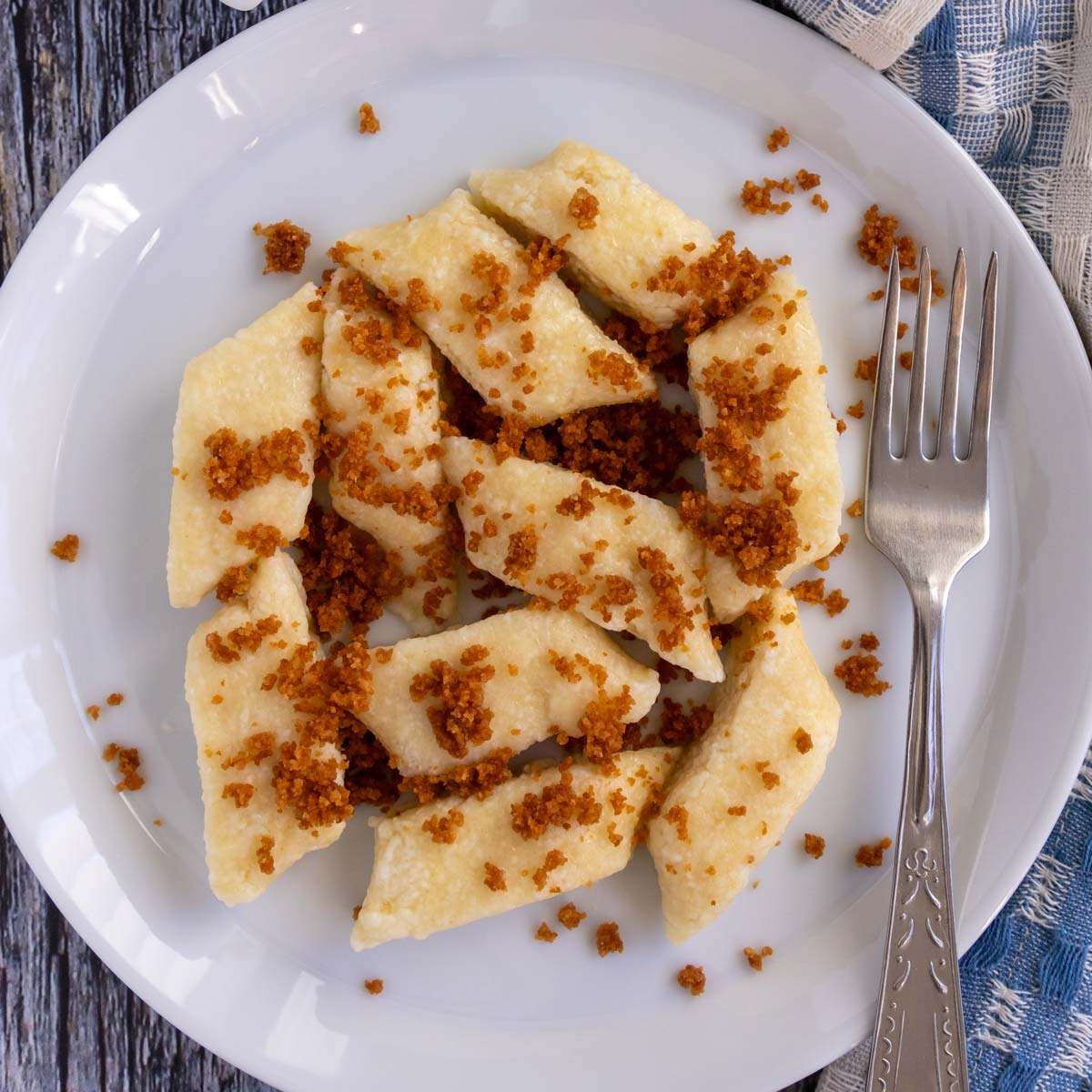
0.0 from 0 votes
Leniwe (Polish Lazy Pierogi Dumplings)
Leniwe, also called Pierogi Leniwe (lazy pierogi) or Kluski Leniwe (lazy dumplings) are traditional Polish dumplings made simply with a handful of ingredients. They are called lazy because they don’t require the time-consuming steps of making typical pierogi, like rolling out dough, filling, and then pinching. These diamond-shaped dumplings are easy to make and can be enjoyed either savory or sweet!
Prep Time
15 mins
Cook Time
15 mins
Total Time
25 mins
Servings: 4 servings
Calories: 404 kcal
Course:
Side Dish , Dessert , Main Course
Cuisine:
Polish
Ingredients
Leniwe (Dumplings):
- 450 grams (1 pound) farmer cheese or twarόg
- 2 large eggs
- ½ teaspoon kosher salt
- 125 grams (1 cup) all-purpose flour
- butter as needed to serve
Bułka Tarta (Buttered Breadcrumbs):
- 28 grams (2 tablespoons) butter
- 40 grams (¼ cup) dry breadcrumbs
Instructions
- In a mixing bowl either mash the cheese with a fork or potato masher, or process it through a potato ricer or food mill to break it up. Mash in the eggs and salt until the mixture is homogeneous.
- Add the flour and stir with a wooden spoon or spatula until combined (don’t knead it, just gently stir/fold together). The dough should be soft and still somewhat sticky. Add more flour if needed to get this texture, but don’t add too much or the dumplings will be tough.
- Bring a large pot of salted water to a boil.
- Make the buttered breadcrumbs by melting the butter in a small skillet and then adding the breadcrumbs. Stir and toast the breadcrumbs in the butter until they are lightly browned, about 2 to 3 minutes. Remove from the heat and set aside.
- To shape the leniwe, dust your work surface with flour and transfer about ¼ of the dough onto the surface. With floured hands, roll the dough into a long rope about 1-to-1 ½-inches thick. Slightly flatten the rope with your hands and then, using a floured knife or bench scraper, cut into pieces at an angle about ¾-inch thick.
- Transfer the cut leniwe to a flour-dusted tray and repeat with the remaining dough.
- When the leniwe are assembled and the water is boiling, cook the dumplings in 2 or more batches. Lower the heat to maintain a gentle simmer, add a portion of the dumplings, stirring carefully so they don’t stick to the bottom, and cook for about 2 minutes or until they float to the surface. Use a slotted spoon or spider skimmer to remove the floating dumplings to a plate or bowl and lightly coat with butter so they don’t stick together. Repeat with the remaining dumplings.
- Serve leniwe topped with buttered breadcrumbs. If desired, you could also sprinkle a little sugar or cinnamon-sugar on top if you’d like to make them sweet rather than savory (this is my preference!).
Cup of Yum
Notes
- Don’t overwork the dough or knead it like you would bread dough. Gently mix it until all the flour is absorbed and the dough looks relatively smooth. It will still be sticky.
- Make sure to coat any leftover cooked leniwe with melted butter before storing in the fridge. This will keep the dumplings from sticking together. Store leftovers for up to 4 days and reheat gently in a pan or microwave.
- Similar to gnocchi, you can freeze uncooked pierogi leniwe. Just make sure to place them in a single layer on a floured surface and freeze until solid. Then transfer to a freezer bag for up to 2 months. Boil them straight from the freezer. They will take an additional minute or two to cook.
- Kluski leniwe are best served hot, as they will harden as they cool. Reheating them will bring them back to their previous, softer, texture.
Nutrition Information
Calories
404kcal
(20%)
Carbohydrates
35g
(12%)
Protein
26g
(52%)
Fat
18g
(28%)
Saturated Fat
10g
(50%)
Polyunsaturated Fat
1g
Monounsaturated Fat
3g
Cholesterol
108mg
(36%)
Sodium
440mg
(18%)
Potassium
70mg
(2%)
Fiber
1g
(4%)
Sugar
4g
(8%)
Nutrition Facts
Serving: 4servings
Amount Per Serving
Calories 404
% Daily Value*
| Calories | 404kcal | 20% |
| Carbohydrates | 35g | 12% |
| Protein | 26g | 52% |
| Fat | 18g | 28% |
| Saturated Fat | 10g | 50% |
| Polyunsaturated Fat | 1g | 6% |
| Monounsaturated Fat | 3g | 15% |
| Cholesterol | 108mg | 36% |
| Sodium | 440mg | 18% |
| Potassium | 70mg | 1% |
| Fiber | 1g | 4% |
| Sugar | 4g | 8% |
* Percent Daily Values are based on a 2,000 calorie diet.